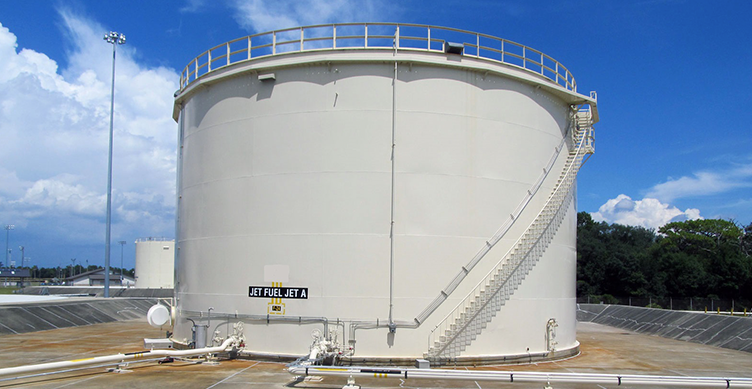*Base security measures prohibit sharing actual images from this job. The above image depicts the nature of our work but is not from the U.S. Navy DFSP in Yokose, Japan.
The fuel farms at Defense Fuel Support Points (DFSPs) hold essential fuel supplies for the U.S. Navy. During an assessment of one of the ten fuel tanks at the DFSP in Yokose, Japan, the inspection revealed the interior of tank Y7 showed signs of wear and age. To return the JP-5 jet fuel tank to full functionality, the base needed an experienced coating contractor.
Scope of the job
To complete this overseas fuel tank interior recoating job, Thomas Industrial Coatings sent a six-man crew, all of whom underwent rigorous background checks to be allowed on the base. Each worker also came prepared with SSPC C-14 Marine Plural Component Spray Operator and SSPC Coating Application Specialist certifications.
The tank was 280 feet in diameter, located 40 feet underground and consisted of 142,000 square feet of steel. The Thomas Industrial Coatings crew on-base was tasked with:
- Abrasive blasting of the tank interior to SSPC SP-10, Near-White Blast Cleaning
- Application of two coats of PolySpec Thiokol, a polysulfide novolac epoxy
- Plural component application at 24 to 30 millimeters thickness
All coatings conformed to United Facilities Guide Specifications (UFGS) 099713.15, Low VOC Polysulfide Interior Coating of Welded Steel Petroleum Fuel Tanks. The coating system needed to meet the base GC’s quality control standards as well as the Navy’s stringent quality assurances.
During the project, the crew used scaffolding to safely access all surface areas of the tank. To maintain humidity below 55% and an 18-degree difference between dew point and steel temperature, equipment for dehumidification, heating, cooling and air movement was also employed. This ensured the steel didn’t rust after abrasive blasting and the coatings cured properly.
The coating system for the jet fuel tank should provide corrosion protection for the next 30 years.
Addressing a common pitting problem
In fuel tanks, small amounts of water often infiltrate the tank and sink to the bottom. There, the water sits on the floor of the tank and eventually creates deep pits, holes and corrosion. This was the case with DFSP Yokose’s tank Y7: Even though the majority of the existing coating was in decent condition, the pitting on the floor of the tank necessitated a recoating.
It’s inevitable for amounts of water to get into the fuel tank. But to prevent this problem from causing significant damage in the future, we sought a solution through the coating system.
The PolySpec Thiokol coating is nearly twice as thick as the previous system and is a 100% liner coating (meaning it is tested for pin holes that would have caused premature failure). With Thomas Industrial Coatings’ recommended coating system, the risk of deep pits, holes and corrosion is reduced significantly.
Maximum preparedness for overseas job
Performing a tank interior coating job is inherently complex, and performing it overseas adds another layer of logistics. Because this job took place in Japan, the team needed to prepare and ship every single piece of equipment well ahead of schedule. (The lead time to ship anything from the U.S. to Japan is five to six weeks.)
Replacement parts, extra materials and repair tools also need to arrive in Yokose. In the U.S., an extra abrasive blast pot or replacement pair of safety glasses could be easily bought off-site or shipped overnight. But with different equipment availability and safety standards, the crew couldn’t rely on vendors in Japan. So the team went into preparation overdrive: Every industrial vacuum, long-reach forklift and pair of gloves came with extras and repair parts, ensuring the team had everything they needed to successfully complete the job on schedule.
Additionally, the 15-hour time difference between Yokose and the Thomas Industrial Coatings shop in Pevely, Missouri required preparedness on communication methods. The teams overseas and stateside took advantage of the few hours each day in which they could discuss the project status over the phone and relied on email to communicate quickly.
Even with the added work that went into prepping for this overseas coating job, the preparedness paid off and the job went as we had planned.
A trusted partner for storage tank coating jobs
Thanks to the hard work of the crew, the JP-5 jet fuel tank for DFSB Yokose will safely hold fuel for the Navy for years to come. And this coating project is just one of many we’ve completed for storage tanks, from fuel tanks for the Department of Defense to water towers in our own backyard.
If you’re ready to hire an experienced, safety-minded contractor for a storage tank coating project, request a bid now to get started. Or read our guide on what to look for when hiring an industrial painter to help you make this critical decision.


